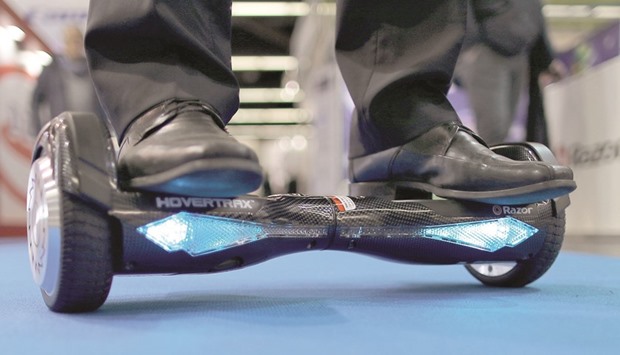In the old days, people used to complain that children were glued to the television. Now they worry that they’re even more under the spell of their smartphones and tablets.
The toy industry first exploited tech and used apps to build out their business. But now they’re also looking to take advantage of the counter trend.
Stress from spending long hours at computers and a lack of movement need some kind of redress, and now there are toys to help people find it.
The industry has even co-opted former US first lady Michelle Obama as its mascot after the success of her “Let’s Move” campaign.
The industry calls it the “Body and Mind” sector, and it’s set to be one of the biggest trends of this year. It was also featured at the world’s largest toy fair, which took place in the German city of Nuremberg recently.
The toys featured included the “Gonge Roller,” which looks a bit like a hoverboard and which is supposed to help develop motor skills and co-ordination, and an electric skateboard that takes a bit of practice to stand on as it whizzes away underneath you.
There’s also a yoga game to encourage aerobics and colouring books – which lately have also been aimed at adults – to help people relax.
It’s difficult to exactly define the segment and its sales figures, because it encompasses such a diverse range of products, says Willy Fischel, director of the German Association of Toy Retailers (BVS).
But “Body and Mind” is a definitely a sector with great potential for the future, he says.
Last year the smartphone app Pokemon Go had people all over the world getting out onto the streets, moving while playing a game.
And this year dancer and engineer Daigo is to unveil a new app which uses sensors in bracelets as well as Bluetooth to transform movements into beats, making the body into an instrument that follows the dance.
While children and young people may no longer be able to imagine their lives without smartphones or tablets, WhatsApp or Instagram, the toy fair’s website suggests that shouldn’t be the case.
Expectations on children to perform well at school have risen, it says, adding, “Such digital and mental strain leads to stress.”
Mathias Albert, a sociologist at the university of Bielefeld who co-wrote a study on youth for oil company Shell, agrees.
“Their life and educational paths are less easy to plan for,” he says. “There’s a lot of uncertainty among children and young people.”
“There’s pressure to get good grades coupled with the question, ‘What use, actually, is a good grade?’”
There’s also a key difference between the age of television and the age of the smartphone, he says, with children and young people now being accessible everywhere and all the time.
“It’s clear that that causes stress,” says Albert.
Stress is also linked to that other buzzword, obesity, which is at record levels around the world.
Children need at least 60 minutes and preferably 90 minutes of exercise a day, according to the World Health Organization (WHO).
“But an alarming percentage of adolescents in Germany don’t even manage that single hour a day of exercise, from moderate to intensive and spread out over that time,” says Swantje Scharenberg, director of a Karlsruhe-based research centre focusing on sport and children (FoSS).
Because children spend their afternoons on the Internet, children are getting less and less exercise, according to Obama’s “Let’s Move” campaign.
Scharenberg also welcomes the toy industry’s move to cash in on the yoga boom. “Whatever helps people exercise, play and do more sport, we should use all of it,” she says.
But Albert disagrees. “The idea of motivating children to do more exercise by using toys, I think, to be honest, is absolute nonsense.”
They just need to go outside, he says, and most have a bike.
What would make more sense to him would be to encourage ideas that use smartphones to get children outside into the fresh air – like Pokemon Go for example.
Scharenberg’s research centre is working on exactly that kind of app; it’s aimed at the whole family, measuring all of their activity and motivating them to take more exercise. -DPA

A man tries out the Hovertrax hoverboard at Nuremberg’s toy fair.
